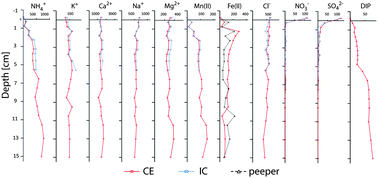A team at The University of Texas at Austin, USA, present the results of a long-term study of polycyclic aromatic hydrocarbon monitoring at a site of contaminated sediment capping by the Anacostia River in Washington DC in this HOT paper, which was featured on the cover of Issue 3.
Capping sediments with clean material to create a barrier between benthic organisms and contamination is a technique to reduce contamination of sediments in situ. PAHs still present an environmental risk long after the source has been eliminated and capping with sand can act as a diffusive barrier giving a clean environment for benthic organisms. Often now materials that actively absorb the contaminants are used, but they usually need a sand layer for benthos organisms to survive.
 The capping took place in 2004 with four different materials – AquaBlokTM (clay-like material with permeability control), coke in a Reactive Core MatTM (to assess low density material in a thin mat), apatite (for heavy metal sequestration) and sand for comparison. The indicator used to assess chemical migration through these materials was monitoring of pore water concentration profiles. Solid-phase concentration could not be used to compare them due to the limited sorption capacity of sand.
The capping took place in 2004 with four different materials – AquaBlokTM (clay-like material with permeability control), coke in a Reactive Core MatTM (to assess low density material in a thin mat), apatite (for heavy metal sequestration) and sand for comparison. The indicator used to assess chemical migration through these materials was monitoring of pore water concentration profiles. Solid-phase concentration could not be used to compare them due to the limited sorption capacity of sand.
They concluded that there were significant concentrations throughout the caps and that the rates of migration in the caps were as expected for the transport characteristics at the site and sorption effect of the materials slowing migration. The caps reached steady state after a few years due to surface re-contamination, however the actual contaminant concentrations were lower than uncapped areas. Tidal dispersion was the primary mixing mechanism in the caps. The team also evaluated bioaccumulation and the ability of pore-water profiling to predict the observed values. Predictions based on pore water concentrations were more accurate than those based on a solid-phase approach.
Read the full discussion of the differences between the capping materials and the results of sampling over time now, as this cover article is still free to access for 5 more weeks*
Long-term PAH monitoring results from the Anacostia River active capping demonstration using polydimethylsiloxane (PDMS) fibers
David J. Lampert, Xiaoxia Lu and Danny D. Reible
DOI: 10.1039/C3EM30826J
*Free access to individuals is provided through an RSC Publishing personal account. Registration is quick, free and simple










